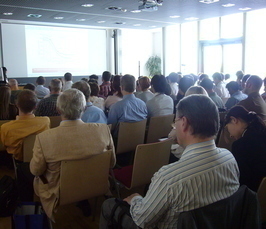MPI Kolloquiumsreihe: Prof. John Yin, Virome dynamics: patterns of virus growth that span the diversity of cellular life
MPI Kolloquiumsreihe: Prof. John Yin, Virome dynamics: patterns of virus growth that span the diversity of cellular life
- Datum: 05.02.2020
- Uhrzeit: 10:00 - 11:00
- Vortragende(r): Prof. John Yin
- Professor of Chemical & Biological Engineering, Vilas Distinguished Achievement Professor, Theme Leader of Wisconsin Institute for Discovery
- Ort: Max-Planck-Institut Magdeburg
- Raum: Großer Seminarraum
- Kontakt: sek-csc@mpi-magdeburg.mpg.de

Das Max-Planck-Institut Magdeburg lädt Sie herzlich zu seiner öffentlichen Kolloquiumsreihe ein. Hochrangige WissenschaftlerInnen verschiedener Fachgebiete aus renommierten Forschungseinrichtungen aus Deutschland und weltweit präsentieren ihre Forschungsarbeit.
Abstract:
Although viruses make up less than 10 percent of the biomass in natural microbial communities, they contribute more than 90 percent of the genome sequences. These virus genomes, now called the “virome,” encode viruses of the Earth’s oceans and terrestrial environments, where they impact microbial and other life across diverse ecological niches, including humans. Most viruses have yet to be isolated or cultured, so little is known about how they grow and persist, but data exists for some. Here we show how an expansive analysis of existing virus and host-cell data can reveal unforeseen patterns of virus-cell interaction and growth. We compiled seven decades of size and growth data on bacterial, archaeal and eukaryotic host cells, including their behavior when infected by viruses from six major classification groups. Simple algorithms enabled estimation of cell sizes and doubling times, as well as yields and delay times for virus production. Cell doubling times correlated with cell size, with larger cells taking longer to divide. Delays in the release of virus progeny from infected cells, which spanned from 10 minutes to one week, scaled with cell volumes, so larger cells release virus after longer delays. Finally, up to 35 percent of host bacterial biomass could be directed toward virus production, while eukaryotes used at most 1 percent of their biomass for virus production. In summary, infected bacteria take less time to make proportionally more virus than infected eukaryotic cells. Integration of biophysical and biochemical data by mathematical and computational modeling may now begin to elucidate mechanisms for these growth behaviors.